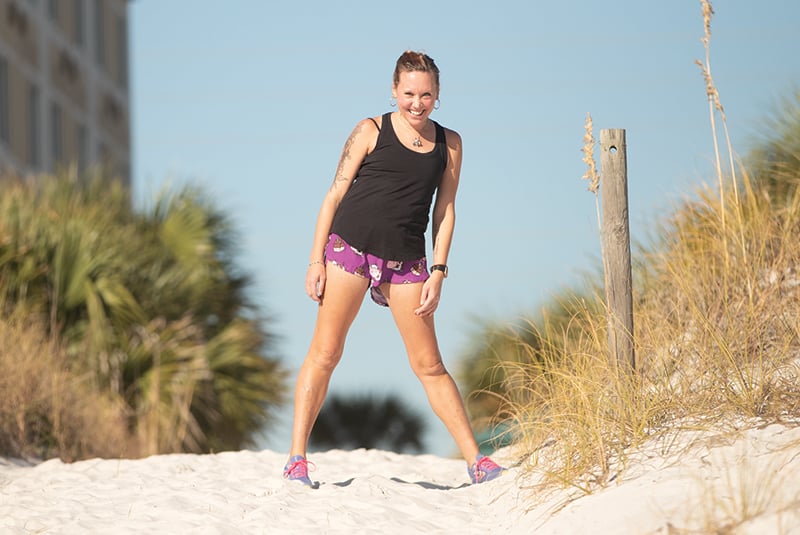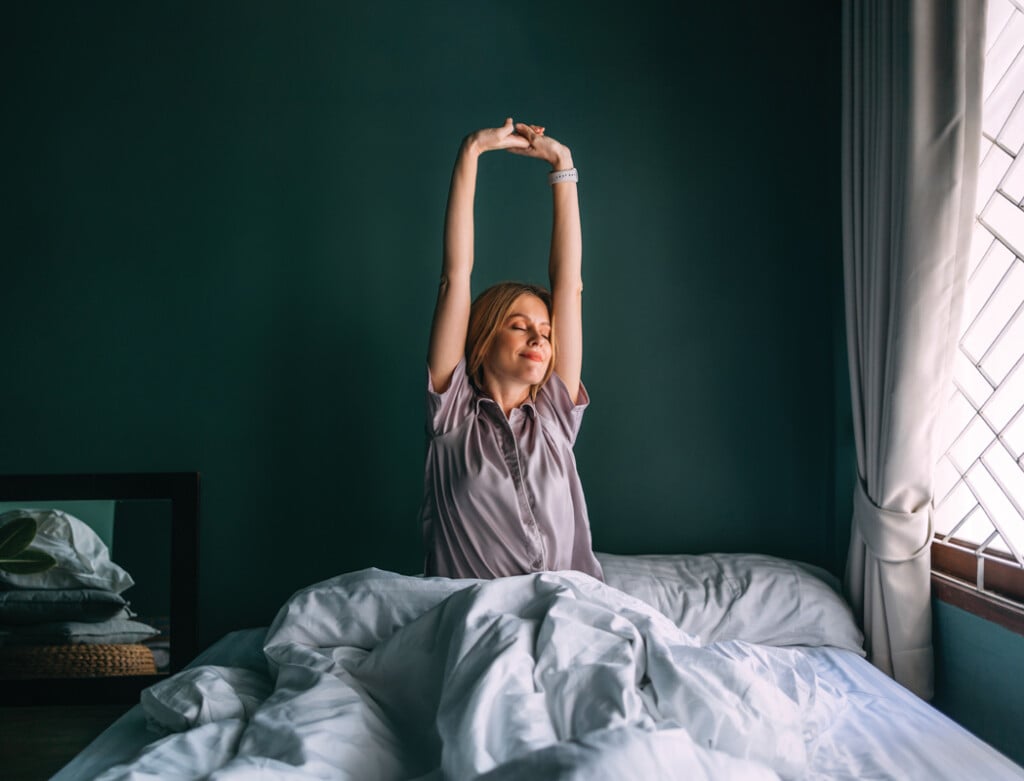Everything to Gain
After decades consumed by an eating disorder, a runner catches up with life

There is almost no photographic record of me between 2009 and 2021. You won’t find me photobombing anyone else’s selfies or tagged in someone else’s photos. You won’t dig up some random shot with me in the background.
The only pictures of me that exist are private photos that I took while deep in the throes of an eating disorder that almost killed me.
Should have killed me.
Every day for months, I would take three photos of myself — left side, right side, frontal — to keep track, to keep score, to make sure that I wasn’t losing control.
In truth, I’d already lost it.
I was terrified of gaining weight, and my body became nothing but skin stretched tightly over a skeleton, so thin that it would tear at the slightest touch. My muscles had withered; my bones had become as fragile as those of an 80-year-old. My hair had thinned and my natural curls had gone into hiding. I went years without a menstrual period.
Most people thought I had cancer.
Some days, I would look in the mirror and see a ghostly wraith staring back at me, this horrible creature that I had become.
What had happened?
My anorexia began when I was 14 at a point when I’d felt as though my world was falling apart. I fell headlong into a mental breakdown. I was overwhelmed by all the noise in my brain, so much so that I did not speak.
Relief only seemed to come when I limited what I ate. Eating was the one thing in my world that I felt like I could control, quantify and understand. Doing so became an all-consuming pursuit that dictated every aspect of my life — where I went, who I saw, what I did every minute of every day. Anyone or anything that threatened that obsession became unsafe in my mind. The list of foods I felt safe eating and the things that I felt safe doing grew smaller and smaller.
My world shrank along with my body.
I’d been an avid runner since the age of 17, and, because I was fast, I’d become well-known in the local running community. I’d run too many races to count, placing in all of them and sometimes winning top overall female honors. My time in my first 26.2-mile race was good enough by six minutes to qualify me for the Boston Marathon, even though I crossed the finish line with a broken ankle.
That injury steepened the slide.
I Googled ways to keep from gaining weight while injured and spent eight weeks riding a stationary bike in the gym and swimming — two activities that my ortho had given me the approval to do. I cut calories from my diet to compensate for the calories I thought I wasn’t burning by not running.

For more than 20 years, Liesel Schmidt battled an eating disorder that reduced her to the weight of a kindergartner and made her bones brittle. Today, her relationship with food has changed dramatically, she has rejoined the world and she has rediscovered herself. Photo by Sean Murphy
When I was healed and running again, I was even faster. I was setting new personal records at almost every race I ran. And the weight kept coming off.
People noticed both the stepped-up speed as well as the drastic weight loss.
My clothes began to fit differently, sliding off my hips and hanging from my frame. One day, I received a call from a close friend and training partner telling me that I’d been banned from racing because the local racing committee was concerned about my very marked weight loss. The next week, my mother got a call from the president of a local running association that I belonged to, a two-hour long call in which he berated her for not doing something to help me.
But there was nothing she could do. I was 26 and the master of my own destiny.
For better or worse.
I saw a slew of doctors and nutritionists, psychiatrists, psychologists and counselors, but I did so only to suspend my parents’ lectures about what I was doing to my body and to our family. I didn’t want help. I didn’t think I needed help.
By the time I turned 28, I’d lost my social network, as it was tightly connected to my running community. I’d disappeared after being banned from racing, and no one reached out. They didn’t understand eating disorders or how to help, and they stayed silent. Consequently, I felt incredibly alone and abandoned by the people I loved.
It seemed like an answer to a prayer when the man I’d been dating for a month proposed.
We were married for eight months but dominated by verbal abuse and manipulation about my weight. While we’d been dating, he humiliated me by weighing me every time I saw him. I remember once standing on the scale in the dark at a restaurant in Pensacola while people walked by. He’d even staged an intervention with my family, promising them that he would “fix” me.
And still, I married him. I’d found myself on a runaway train, and walking down the aisle seemed my only failsafe when I felt the world once again falling apart.
When my husband committed suicide, I felt no grief. How could I? My marriage had been a horrible mistake, and I was finally freed of its dangers.
But I was still in danger of my own making.
Over the next eight years, I lived on my own, getting deeper and deeper into the eating disorder that still felt like the only way for me to have a measure of control. Even though my logical brain knew I needed to eat far more than I was, I couldn’t. I was terrified of it to the point of literal nightmares.
Even a broken hip that required emergency surgery and two months of recovery time in 2017 didn’t derail me. Nor did the fact that my orthopedic surgeon had very little confidence that I would live through surgery because of my extremely low weight and how much it would tax my compromised heart.
Despite that assessment, which the doctor shared with my parents, my surgery went well. I was sent home with a repaired hip and little more than directions for how to navigate the coming weeks of healing.
Over those eight weeks, I was stripped of control. I couldn’t come or go as I wanted, couldn’t drive, couldn’t exercise, couldn’t prepare my own meals. That task was left to my mother, who carefully studied how to get me the calories I needed without running the risk of refeeding syndrome, which can be deadly to someone as undernourished as I was.
And yet, I still lost weight. By the end of 2019, there was nothing left of me to lose.
At 36 years old, I weighed as little as a kindergartener and was osteoporotic, with a body that was almost constantly in pain. I could count every rib, even run my fingers over my right hip and feel the heads of the screws and the plate where they’d put me back together.
I had become a creature that people would whisper about, point to and laugh at. But no one seemed to understand the hell and the prison I was living in.
And then, God set me free.

Since escaping the clutches of anorexia, Liesel Schmidt has grown in confidence and has become willing to share photos of herself on social media. She has discovered, too, an appetite for travel and has made multiple trips to the small town in Germany where she lived as a small child. Photo courtesy of Liesel Schmidt
Not that I didn’t go kicking and screaming.
What terrified me was that all of it seemed to be happening without my consent. Suddenly, it was as though my survival instincts took over and wrestled the noise in my brain to the ground. I began eating — a lot. Entire boxes of Pop-Tarts, whole bags of chips, massive containers of cashews — anything that looked good was fair game. All the things that had once been so “unsafe” became my way back to health — and my way back to living.
But because I felt out of control, I also felt ashamed. The changes I saw in the mirror were not ones I felt I could live with. It was everything I had been so afraid of, come to life in my reflection. And though the wraith was slowly being replaced by a fuller me, I couldn’t deal with the woman in the mirror.
As a result, I spent the entire year of 2020 hiding from my family as well as the rest of the world. Even before anyone had even heard whispers of COVID, I had begun my own self-quarantine, staying sheltered in a place where I felt safe, away from anyone’s eyes or judgment.
I gave no explanations for my sudden disappearance from life. No one knew what I’d been going through, and no matter how many times my mother asked me what was going on, I couldn’t bring myself to say the words, “I’m gaining weight.”
By the time Christmas was in view, it had been almost a year since I’d last seen my family, and I knew I couldn’t stay away any longer, even though I was still struggling with self-acceptance.
I knocked on my parents’ door on Dec. 23, terrified. After all, if I couldn’t accept this new version of myself, how would they?
I was crying hysterically when my mom opened the door. I was ashamed of how I looked and fearful about how she would react to the changes in me.
But what I saw in her tear-filled eyes was relief, disbelief and absolute joy. Standing there was a person who had been dead for so long, now alive and vibrant again.
The love I felt from her and the rest of my family enabled me to begin to accept the change. I felt like I had been set free and given the world.
Not that it’s been easy. I have worked hard on how I perceive myself, and I have dealt with the realization that I lived a lie for too many years. Still, I struggle to accept aspects of myself that I’m not completely satisfied with. But I am truly fully alive and healthy. And strong. And independent. And so many other things that I had once been robbed of.
I laugh easily and often. I eat with enjoyment and free of worry. I embrace challenges and change. And I love.
I feel sometimes as though I was missing for years, that the world moved on without me while I stayed stuck behind the bars of my eating disorder and all the psychological and physical damage it inflicted.
But I have come back to life from that place of nothingness. And if you look for them, you can find photos of me, living free.


